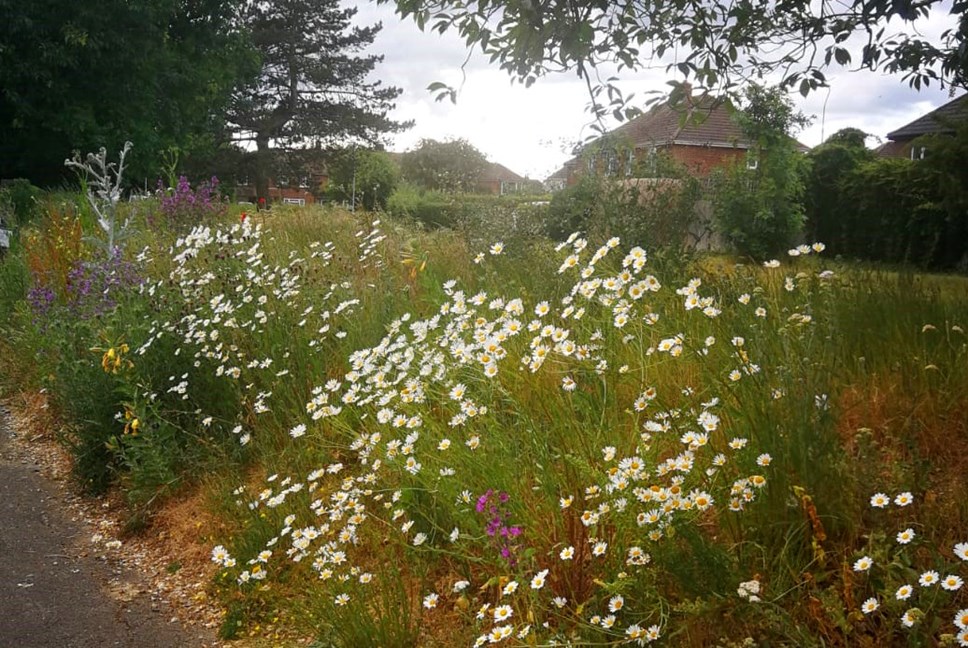
Reading Council to Extend Successful ‘Rewilding’ Trial to Parks
- Experimental rewilding scheme introduced in 2020 has proved a great success.
- The new 'Wild Flower Plan' proposes trialling the scheme in 12 parks
READING COUNCIL has announced plans to extend its innovative ‘Rewilding’ trial to restore, reclaim and protect natural habitats and native species on highway verges across the borough.
The experimental rewilding scheme, which introduced a new approach to grass cutting in selected locations across Reading during 2020, has proved a great success. The end of season review concluded that the experiment had worked in most areas for both maintenance and appearance and public feedback on the scheme had been overwhelmingly positive.
A ‘Rewilding and Wildflower Plan’ report will be considered at a meeting of the Council’s Housing, Neighbourhoods and Leisure Committee (HNLC) tomorrow (Tuesday 15 December). The report summarises the results of this year’s activity and makes recommendations to extend the project in 2021.
As well as extending the new scheme across new areas of the borough – including Wensley Road green, Cintra Avenue and parts of Milestone Way, the Wild Flower Plan proposes trialling the scheme in 12 parks, which would add 2 ha (5%) to the overall amount of conservation grass.
Other exciting plans include wildflower planting in the town centre and around the Civic Offices, on selected roundabouts and around the main shopping areas in Tilehurst, Caversham and Whitley, where there is land for planting, as well as corridors into Reading, like the A33, Oxford Road, London Road and Henley Road.
As with the 2020 rewilding project, requests for feedback from local residents and parks users will be sought and the new changes carefully reviewed at the end of the season.
Cllr Karen Rowland, Reading’s Lead for Culture, Heritage and Recreation, said:
“I am absolutely delighted our Rewilding trial has proved so successful during 2020 – many of our verges looked lovely during the summer – the range of biodiversity on the Hexham Road, the spectacular array of wildflowers along Lansdowne Road and the sea of buttercups at Florian Gardens were particular highlights this year. The positive feedback from residents has been heartening to see.
“Rewilding connects people back with nature. In busy towns such as Reading, maintaining that connection with nature is all the more important. This year has been a perfect time to rewild our town – when residents are walking and cycling more. This project has tied in nicely with our focus on active travel and the new schemes we have introduced to encourage more sustainable travel across the borough.
“Many people have urged us to make more changes that improve things for wildlife in the town and in our parks – and this is the direction we hope to expand the trial towards in 2021. We have ambitions to increase wild areas in 12 of our parks.
“Importantly, these experimental changes feed into our wider, far-reaching ambitions set out in the Climate Emergency Strategy and Biodiversity Action Plan.
“As we suspected during the course of the trial, we discovered that some verges looked wonderful because they are species-rich, whilst others did not, and we now have a clearer picture on this in order to move the project forward.
“The project is now embedded in the Council’s approach to grassland management, although changes can be made to specific sites. Most of the rewilded sites will be accepted at the next Housing, Neighbourhoods and Leisure Committee, and next year we plan both to trial new sites and to reintroduce mowing where rewilding does not ‘work’ either ecologically or visually.
“We are very grateful to everyone who took the time to feedback to us and we encourage everyone to continue to tell us what they think about the changes during 2021. You can send us an email at rewilding@reading.gov.uk and visit www.reading.gov.uk/rewilding to find out more. Please do tell us if you spot any unusual plants, insects or birds on your travels.”
West Reading residents, Hilary and Mike said: “We would like to thank you for what is being done on the 'rewilding' project. Since lockdown my husband and I have taken daily walks around Prospect Park and Southcote and have been delighted by the beautiful wildflowers and grasses that now grow in the verges and meadow areas. It is a joy to watch the different varieties of plants growing through the weeks and seeing all the insects, bees and birds that they attract. Please keep it going!”
View the full Housing, Neighbourhoods and Leisure Committee (HNLC) report at:
https://democracy.reading.gov.uk/ieListDocuments.aspx?CId=140&MId=3463
Ends
Notes to editors
Rewilding of urban areas is being encouraged across the country. There are several national campaigns, like Rewilding Britain, the Blue Campaign, and the Royal Horticultural Society programme to encourage wilding of urban gardens.
In 2018 the Council declared a climate emergency, together with partners from all walks of life. The Reading Climate Change Partnership has produced the Reading Climate Emergency Strategy (RCES). The ‘Nature’ theme of the strategy is a wide-ranging requirement to improve the urban environment for flora and fauna.
The rewilding project is also a key part of the Council’s new Biodiversity Action Plan.
The plan is focused on promoting natural solutions to climate challenges, such as improving habitats to help wildlife and people adapt to the impacts of climate change. It sets out priority objectives and actions for the protection and enhancement of biodiversity within Reading. One of which is to review the mowing regime of highways verges to allow, where appropriate, more species-rich long grass in corridors along the highway. This creates corridors for small animals and insects to move around town, as well as providing food for birds and insects.
